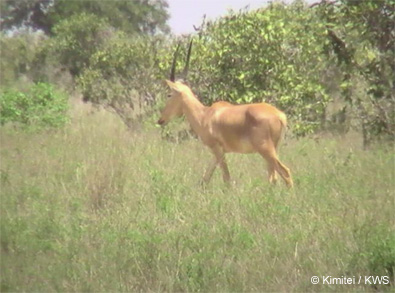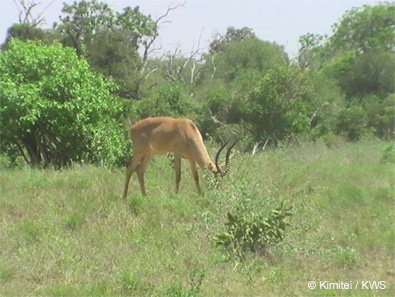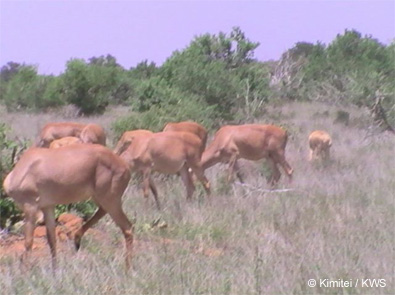Here is the latest updated from Kimitei, our EDGE Fellow monitoring Africa’s most threatened antelope – the hirola:
It has been a great rainy season in the Tsavo East National Park for the last 2 weeks whereby the vegetation change is evident. During the survey, no new groups were identified but the former identified groups were monitored. Due to favourable conditions prevail in the hirola range, most of the groups are leaving their former places where they were sighted during the dry season to new areas.
Most typical example is the Mukwaju 2 (M2) group where some group changes had occurred. The group split to two groups of 5 and 9. Later on 5 calves were added to the group making the group 19. The group reunited and split again separating the 3 yearling females. Lastly, the group regrouped again and moved out of the area. A thorough search in the area for two weeks did not yield anything. It is during this time that we had the rough time since we had many question to answer though no answers at that moment. This question were, one, did the cheetah got up with the group? If yes, what might have happened to the calves, their mothers, the whole group? Two, where again can I find such a large group again?
Our survey continued the third week with minimum expectation to meet the M2 group. Hope came in to search for new individuals or group. In this week, we spent most of our time within Aruba and Satao. The search yielded identification of three lone males in three different places. All of the lone males were yearlings much probably born in the last season. They were energetic and strong. One of them was alone with no associate species, zebra, grant gazelles accompanied the second, and last one was with grants and giraffes.
It is during this week that we came across a group of 16 individuals. From close identification, we realized that the group was M2. M2 group had a female adult with short tail, which we identified. The calves were five with the same age variation as that of M2. The age structure and sex composition really helped in our identification. The M2 group has even given us a hint that the group can move far away from the area known to be. From the place where they were sighted last and the place they were sighted is 8.5 km apart.
As we are talking, the known Tsavo Population is now 48 individuals. Hope is high that new groups or individuals would be sighted.
If you would like to support research and conservation of forgotten EDGE species, then you can become an EDGE Champion, or donate here.


